Identification of Energy Storage in Distribution Channels
Abstract
1. Introduction
2. Literature Review
2.1. Electricity Production
2.2. Energy Storage
2.3. District Heating and Heat Storage
3. Materials and Methods
- —weighted average cost of capital;
- —capital expenditure incurred in year .
- —capital expenditures;
- —change in property, plant, and equipment.
- —free cash flow to equity;
- —earnings per share;
- —CapEx;
- —depreciation;
- —debt ratio;
- —∆Net capital, which is a change in net working capital.
- —net income;
- —net CapEx;
- —new debt;
- —debt repayment;
- —operating costs of the heating plant in year .
- -
- Fuel and energy: The consumption of electricity purchased from the National Power System in individual time zones is entered by summing up the values for all devices operating in the energy generation range in individual time zones of the day. These values should be confirmed by calculations prepared by the electricity distributor and made available to the NCBR. It is filled in by entering the total for all devices operating in the energy generation range in individual time zones of the day for energy purchased from RESs. The price forecast is automatically retrieved from the energy operators’ database. Production should therefore be reduced by losses during transmission, storage, or efficiency in relation to fuel and energy consumption. This gives us the actual structure of heat demand coverage by all production installations.
- -
- Repairs: Quantities and purchase prices of various specific additives, materials, and substrates that are not included in repairs and maintenance. This gives us a category of direct costs that is not included in other calculations. They include price forecasts for the 20 most popular substrates used in RESs. Annual repair costs were proposed as a percentage of the initial expenditure on the fixed asset.
- -
- Maintenance and inspections: Annual maintenance and inspection costs were proposed as a percentage of the initial expenditure on the fixed asset.
- -
- Service and salary costs: Allows these costs to be entered in two ways (combined or separately). First, they should be supplemented with service costs expressed in their actual, real values. This approach is particularly applicable in the case of outsourced services, but not only. Second, service costs are calculated based on the number of hours allocated to servicing all devices per year (applied primarily to the settlement of full-time employees).
- -
- Overhead costs: The level of overhead costs is calculated automatically and amounts to 10% of fuel, energy, repair, and maintenance costs. The energy operator should also specify any specific costs for the proposed technologies that are not included elsewhere, as well as public expenditure on concessions, taxes, environmental charges, etc. The volume of production covered by CO2 emission allowances should be added. The operator enters specific expenses for the technology used, e.g., public obligations such as taxes, concessions, other environmental charges, etc.
- -
- Economic effect of energy sales to the energy system: This item refers to additional revenue from the sale of electricity generated (e.g., in a photovoltaic installation) that was not used in heat generation installations during the summer. Enter a positive value. Due to the fact that the main purpose of the analysis is heat generation and supply, a distribution key for the cost of heat generation has been defined to avoid subsidization (the share of heat in the total volume of electricity and heat generated). It is used to proportionally reduce the share of heat inputs that are exclusively involved in the generation of surplus electricity. The revenues obtained in this way will reduce the value of energy production costs.
4. Results
5. Conclusions
Author Contributions
Funding
Data Availability Statement
Conflicts of Interest
References
- Energy from Renewable Sources in 2023. Statistical Analyses. Eds. Statistical Poland, Warsaw. 2024. Available online: https://stat.gov.pl/en/topics/environment-energy/energy/energy-from-renewable-sources-in-2023,9,3.html (accessed on 17 July 2025).
- Chodkowska-Miszczuk, J.; Szymańska, D. Odnawialne źródła energii w produkcji energii elektrycznej w Polsce. Naucz. Przedmiotów Przyr. 2012, 41, 4. [Google Scholar]
- Gabryś, H. Elektroenergetyka w Polsce 2020. Energetyka 2020, 8, 365–373. [Google Scholar]
- Nallolla, C.A.; Chittathuru, P.V.D.; Padmanaban, S. Multi-objective optimization algorithms for a hybrid AC/DC microgrid using RES: A comprehensive review. Electronics 2023, 12, 1062. [Google Scholar] [CrossRef]
- Tumeran, N.L.; Yusoff, S.H.; Gunawan, T.S.; Hanifah, M.S.A.; Zabidi, S.A.; Pranggono, B.; Halbouni, A.H. Model predictive control based energy management system literature assessment for RES integration. Energies 2023, 16, 3362. [Google Scholar] [CrossRef]
- Erbach, G.; Jensen, L. Fit for 55 Package. EPRS, European Parliament. 2022. Available online: https://policycommons.net/artifacts/11463736/fit-for-55-package/12354871/ (accessed on 17 July 2025).
- Pérez de las Heras, B. The ‘Fit for 55’package: Towards a more integrated climate framework in the EU. Rom. J. Eur. Aff. 2022, 22, 63–78. [Google Scholar]
- Brożyna, J.; Lu, J.; Strielkowski, W. Is European current climate regulation strategy feasible? A comparative analysis of “Fit for 55” green transition package for V4 and LEU4. Energy Strategy Rev. 2025, 61, 101843. [Google Scholar] [CrossRef]
- Kaznowski, R.; Sztafrowski, D. System elektroenergetyczny oparty o odnawialne źródła energii-możliwości i bariery rozwoju. Przegląd Elektrotechniczny 2023, 99, 186–189. [Google Scholar] [CrossRef]
- Bielecki, A.; Ernst, S.; Skrodzka, W.; Wojnicki, I. The externalities of energy production in the context of development of clean energy generation. Environ. Sci. Pollut. Res. 2020, 27, 11506–11530. [Google Scholar] [CrossRef]
- Tiruye, G.A.; Besha, A.T.; Mekonnen, Y.S.; Benti, N.E.; Gebreslase, G.A.; Tufa, R.A. Opportunities and challenges of renewable energy production in Ethiopia. Sustainability 2021, 13, 10381. [Google Scholar] [CrossRef]
- Sułek, A.; Borowski, P.F. Business Models on the Energy Market in the Era of a Low-Emission Economy. Energies 2024, 17, 3235. [Google Scholar] [CrossRef]
- Madler, J.; Harding, S.; Weibelzahl, M. A multi-agent model of urban microgrids: Assessing the effects of energy-market shocks using real-world data. Appl. Energy 2023, 343, 121180. Available online: https://www.sciencedirect.com/science/article/pii/S0306261923005445 (accessed on 17 July 2025). [CrossRef]
- Rybarz, M. Transformacja energetyczna jako katalizator zmian strukturalnych w gospodarce. Zesz. Nauk. Inst. Gospod. Surowcami Miner. I Energią PAN 2024, 112, 73–82. Available online: https://bibliotekanauki.pl/articles/59112300 (accessed on 12 July 2025).
- Sequeira, T.N.; Santos, M.S. Does country-risk influence electricity production worldwide? J. Policy Model. 2018, 40, 730–746. [Google Scholar] [CrossRef]
- Yu, B.; Fang, D.; Yu, H.; Zhao, C. Temporal-spatial determinants of renewable energy penetration in electricity production: Evidence from EU countries. Renew. Energy 2021, 180, 438–451. [Google Scholar] [CrossRef]
- Arbabzadeh, M.; Sioshansi, R.; Johnson, J.X.; Keoleian, G.A. The role of energy storage in deep decarbonization of electricity production. Nat. Commun. 2019, 10, 3413. Available online: https://www.nature.com/articles/s41467-019-11161-5 (accessed on 17 July 2025). [CrossRef]
- Safarzadeh, H.; Di Maria, F. How to Fit Energy Demand Under the Constraint of EU 2030 and FIT for 55 Goals: An Italian Case Study. Sustainability 2025, 17, 3743. [Google Scholar] [CrossRef]
- Lehnert, W.; Traum, Y. The ‘new’Renewable Energy Directive (RED III): An overview. Eur. Energy Clim. J. 2024, 12, 40–47. [Google Scholar] [CrossRef]
- Gajdzik, B.; Wolniak, R.; Nagaj, R.; Žuromskaitė-Nagaj, B.; Grebski, W.W. The influence of the global energy crisis on energy efficiency: A comprehensive analysis. Energies 2024, 17, 947. [Google Scholar] [CrossRef]
- Niestępska, M. Priorytety likwidacji barier prawnych w energetycznej transformacji ciepłownictwa w ocenie branży ciepłowników i przedstawicieli regulatora. Dist. Heat. Instal. 2025, 4, 12–20. [Google Scholar] [CrossRef]
- Mir, M.Y. Sustainable Fuels Production; Springer Nature: Berlin/Heidelberg, Germany, 2025. [Google Scholar] [CrossRef]
- Ilves, R.; Küüt, A.; Allmägi, R.; Olt, J. The Impact of RED III Directive on the Use of Renewable Fuels in Transport on the Example of Estonia. Rigas Teh. Univ. Zinat. Raksti 2024, 28, 165–180. [Google Scholar] [CrossRef]
- Halkos, G.; Zisiadou, A. Energy crisis risk mitigation through nuclear power and RES as alternative solutions towards self-sufficiency. J. Risk Financ. Manag. 2023, 16, 45. [Google Scholar] [CrossRef]
- Dell, R.M.; Rand, D.A.J. Energy storage—A key technology for global energy sustainability. J. Power Sources 2001, 100, 2–17. [Google Scholar] [CrossRef]
- Yao, Z.; Lum, Y.; Johnston, A.; Mejia-Mendoza, L.M.; Zhou, X.; Wen, Y.; Seh, Z.W. Machine learning for a sustainable energy future. Nat. Rev. Mater. 2023, 8, 202–215. [Google Scholar] [CrossRef] [PubMed]
- Bellani, J.; Verma, H.K.; Khatri, D.; Makwana, D.; Shah, M. Shale gas: A step toward sustainable energy future. J. Pet. Explor. Prod. Technol. 2021, 11, 2127–2141. [Google Scholar] [CrossRef]
- Garitaonandia, E.; Arribalzaga, P.; Ibon, M.; Bielsa, D. Characterization of the Ratcheting Effect on the Filler Material of a Steel Slag-Based Thermal Energy Storage. Energies 2024, 17, 1515. [Google Scholar] [CrossRef]
- Sayed, E.T.; Olabi, A.G.; Alami, A.H.; Radwan, A.; Mdallal, A.; Rezk, A.; Abdelkareem, M.A. Renewable energy and energy storage systems. Energies 2023, 16, 1415. [Google Scholar] [CrossRef]
- Wang, W.; Yuan, B.; Sun, Q.; Wennersten, R. Application of energy storage in integrated energy systems—A solution to fluctuation and uncertainty of renewable energy. J. Energy Storage 2022, 52, 104812. [Google Scholar] [CrossRef]
- Arce, P.; Medrano, M.; Gil, A.; Oró, E.; Cabeza, L.F. Overview of thermal energy storage (TES) potential energy savings and climate change mitigation in Spain and Europe. Appl. Energy 2011, 88, 2764–2774. [Google Scholar] [CrossRef]
- Prawo Energetyczne i Ustawy o Odnawialnych Źródłach Energii. Available online: https://eli.gov.pl/eli/DU/2022/2370/ogl (accessed on 12 July 2025).
- Mitali, J.; Dhinakaran, S.; Mohamad, A.A. Energy storage systems: A review. Energy Storage Sav. 2022, 1, 166–216. [Google Scholar] [CrossRef]
- Liu, J.; Hu, H.; Yu, S.S.; Trinh, H. Virtual power plant with renewable energy sources and energy storage systems for sustainable power grid-formation, control techniques and demand response. Energies 2023, 16, 3705. [Google Scholar] [CrossRef]
- Duda, J.; Fierek, S.; Karkula, M.; Kisielewski, P.; Puka, R.; Redmer, A.; Skalna, I. Determining lower bound on number of vehicle blocks in multi-depot vehicle scheduling problem with mixed fleet covering electric buses. Arch. Transp. 2023, 65, 27–38. [Google Scholar] [CrossRef]
- Poorani, S.; Jebarani Evangeline, S.; Bagyalakshmi, K.; Maris Murugan, T. Management Systems through Deep Learning-Based Cell Balancing Mechanisms. Eksploat. I Niezawodn. 2025, 27, 200714. [Google Scholar] [CrossRef]
- Zhu, L. Energy management in microgrid integrated with ultracapacitor-equipped electric vehicles and renewable resources using Hybrid Algorithm Perspective. Eksploat. I Niezawodn. 2025, 27, 200713. [Google Scholar] [CrossRef]
- Wade, N.; Taylor, P.; Lang, P.; Jones, P. Evaluating the benefits of an electrical energy storage system in a future smart grid. Energy Policy 2010, 38, 7180–7188. [Google Scholar] [CrossRef]
- Lindholm, O.; Rehman, H.U.; Reda, F. Positioning positive energy districts in European cities. Buildings 2021, 11, 19. [Google Scholar] [CrossRef]
- Schubert, C.; Hassen, W.F.; Poisl, B.; Seitz, S.; Schubert, J.; Oyarbide Usabiaga, E.; Gaudo, P.M.; Pettinger, K.H. Hybrid energy storage systems based on redox-flow batteries: Recent developments, challenges, and future perspectives. Batteries 2023, 9, 211. [Google Scholar] [CrossRef]
- Marocco, P.; Ferrero, D.; Gandiglio, M.; Ortiz, M.M.; Sundseth, K.; Lanzini, A.; Santarelli, M. A study of the techno-economic feasibility of H2-based energy storage systems in remote areas. Energy Convers. Manag. 2020, 211, 112768. [Google Scholar] [CrossRef]
- Wu, H.; Shan, C.; Fu, S.; Li, K.; Wang, J.; Xu, S.; Hu, C. Efficient energy conversion mechanism and energy storage strategy for triboelectric nanogenerators. Nat. Commun. 2024, 15, 6558. [Google Scholar] [CrossRef]
- Ullah, Z.; Qazi, H.S.; Rehman, A.U.; Hasanien, H.M.; Wang, S.; Elkadeem, M.R.; Badshah, F. Efficient energy management of domestic loads with electric vehicles by optimal scheduling of solar-powered battery energy storage system. Electr. Power Syst. Res. 2024, 234, 110570. [Google Scholar] [CrossRef]
- Gissey, G.C.; Dodds, P.E.; Radcliffe, J. Market and regulatory barriers to electrical energy storage innovation. Renew. Sustain. Energy Rev. 2018, 82, 781–790. [Google Scholar] [CrossRef]
- Zeh, A.; Müller, M.; Naumann, M.; Hesse, H.C.; Jossen, A.; Witzmann, R. Fundamentals of using battery energy storage systems to provide primary control reserves in Germany. Batteries 2016, 2, 29. [Google Scholar] [CrossRef]
- Mrozowska, S.; Wendt, J.A.; Tomaszewski, K. The challenges of Poland’s energy transition. Energies 2021, 14, 8165. [Google Scholar] [CrossRef]
- Mieński, R.; Wasiak, I.; Kelm, P. Integration of PV Sources in Prosumer Installations Eliminating Their Negative Impact on the Supplying Grid and Optimizing the Microgrid Operation. Energies 2023, 16, 3479. [Google Scholar] [CrossRef]
- Lei, Z.; Zheng, Z.; Zhang, L. Current Harmonics Suppression Scheme for GaN-Based DCM Grid-Tied Micro-Inverters. In Proceedings of the PEAS 2023–2023 IEEE 2nd International Power Electronics and Application Symposium, Conference Proceedings, Guangzhou, China, 10–13 November 2023. [Google Scholar] [CrossRef]
- Nguyen-Tuan, A.; Ta-Duy, B.; Nguyen-Duc, T.; Fujita, G. A novel approach to optimize and allocate battery energy storage system in distributed grid considering impact of demand response program. Sustain. Energy Grids Netw. 2025, 43, 101738. [Google Scholar] [CrossRef]
- Ipsakis, D.; Voutetakis, S.; Seferlis, P.; Stergiopoulos, F.; Elmasides, C. Power management strategies for a stand-alone power system using renewable energy sources and hydrogen storage. Int. J. Hydrogen Energy 2009, 34, 7081–7095. [Google Scholar] [CrossRef]
- Suresh, C.; Saini, R.P. Thermal performance of sensible and latent heat thermal energy storage systems. Int. J. Energy Res. 2020, 44, 4743–4758. [Google Scholar] [CrossRef]
- Wang, X.; Zhang, N.; Li, D.; Du, Z.; Feng, Y.; Liu, D. Development Status and Prospect of Distributed New Energy Participating in Power Market. In Proceedings of the 2023 4th International Conference on Advanced Electrical and Energy Systems (AEES), Shanghai, China, 1–3 December 2023. [Google Scholar] [CrossRef]
- Simpeh, E.K.; Pillay, J.P.G.; Ndihokubwayo, R.; Nalumu, D.J. Improving energy efficiency of HVAC systems in buildings: A review of best practices. Int. J. Build. Pathol. Adapt. 2022, 40, 165–182. [Google Scholar] [CrossRef]
- Kim, D.; Lee, J.; Do, S.; Mago, P.J.; Lee, K.H.; Cho, H. Energy modeling and model predictive control for HVAC in buildings: A review of current research trends. Energies 2022, 15, 7231. [Google Scholar] [CrossRef]
- Navarro, L.; De Gracia, A.; Colclough, S.; Browne, M.; McCormack, S.J.; Griffiths, P.; Cabeza, L.F. Thermal energy storage in building integrated thermal systems: A review. Part 1. active storage systems. Renew. Energy 2016, 88, 526–547. [Google Scholar] [CrossRef]
- Elkhatat, A.; Al-Muhtaseb, S.A. Combined “renewable energy–thermal energy storage (RE–TES)” systems: A review. Energies 2023, 16, 4471. [Google Scholar] [CrossRef]
- Chicco, J.M.; Mandrone, G. Modelling the energy production of a borehole thermal energy storage (BTES) system. Energies 2022, 15, 9587. [Google Scholar] [CrossRef]
- Mousavi Ajarostaghi, S.S.; Amiri, L.; Poncet, S. Application of Thermal Batteries in Greenhouses. Appl. Sci. 2024, 14, 8640. [Google Scholar] [CrossRef]
- Song, L.; Guo, W.; He, Z.; Zhang, P. Thermal, economic and food preservation performances of a refrigerated warehouse equipped with on-shelf phase change material. Int. J. Refrig. 2024, 165, 16–30. [Google Scholar] [CrossRef]
- Vadiee, A.; Martin, V. Thermal energy storage strategies for effective closed greenhouse design. Appl. Energy 2013, 109, 337–343. [Google Scholar] [CrossRef]
- Jałowiec, T.; Wojtaszek, H.; Miciuła, I. Analysis of the potential management of the low-carbon energy transformation by 2050. Energies 2022, 15, 2351. [Google Scholar] [CrossRef]
- Chudy-Laskowska, K.; Pisula, T. An analysis of the use of energy from conventional fossil fuels and Green renewable energy in the context of the European Union’s planned energy transformation. Energies 2022, 15, 7369. [Google Scholar] [CrossRef]
- Tao, M.; Yu, Y.; Zhang, H.; Ye, T.; You, S.; Zhang, M. Research on the optimization design of solar energy-gas-fired boiler systems for decentralized heating. Energies 2021, 14, 3195. [Google Scholar] [CrossRef]
- Halam, R.; Raman, R. Enhancing Energy Efficiency in Solar Water Heating Systems for Sustainable Homes with IoT Technology. In Proceedings of the 2023 International Conference on Innovative Computing, Intelligent Communication and Smart Electrical Systems, ICSES 2023, Chennai, India, 14–15 December 2023. Date Added to IEEE Xplore 19 March 2024. [Google Scholar] [CrossRef]
- Alawi, O.A.; Kamar, H.M.; Mallah, A.R.; Mohammed, H.; Sabrudin, M.A.S.; Newaz, K.M.S.; Najafi, G.; Yaseen, Z.M. Experimental and theoretical analysis of energy efficiency in a flat plate solar collector using monolayer graphene nanofluids. Sustainability 2021, 13, 5416. [Google Scholar] [CrossRef]
- Krinitsky, M.; Averbukh, M. Control and Managing of Individual Solar Water Heating Systems in an Apartment Complex. Electronics 2024, 13, 2305. [Google Scholar] [CrossRef]
- Xin, X.; Liu, Y.; Zhang, Z.; Zheng, H.; Zhou, Y. A day-ahead operational regulation method for solar district heating systems based on model predictive control. Appl. Energy 2025, 337, 124619. [Google Scholar] [CrossRef]
- Jafari, S.; Sohani, A.; Hoseinzadeh, S.; Pourfayaz, F. The 3E Optimal Location Assessment of Flat-Plate Solar Collectors for Domestic Applications Iran. Energies 2022, 15, 3589. [Google Scholar] [CrossRef]
- Liyew, K.W.; Louvet, Y.; Habtu, N.G.; Jordan, U. Experimental investigations of the operating behaviour of a low-flow drainback solar heating system. Energy Rep. 2025, 13, 594–608. [Google Scholar] [CrossRef]
- Bellos, E.; Tzivanidis, C. Investigation of a novel CO2 transcritical organic rankine cycle driven by parabolic trough solar collectors. Appl. Syst. Innov. 2021, 4, 53. [Google Scholar] [CrossRef]
- Bugała, A.; Bugała, D.; Jajczyk, J.; Dąbrowski, T. Statistical Analysis of Electrical and Non-Electrical Parameters of Photovoltaic Modules in Controlled Tracking Systems Artur Bugała. Rocz. Ochr. Srodowiska 2021, 23, 694–714. [Google Scholar] [CrossRef]
- Orosz, T.; Rassolkin, A.; Arsenio, P.; Poor, P.; Valme, D.; Sleisz, A. Current Challenges in Operation, Performance, and Maintenance of Photovoltaic Panels. Energies 2024, 17, 1306. [Google Scholar] [CrossRef]
- Olchowik, W.; Bednarek, M.; Dąbrowski, T.; Rosiński, A. Application of the Energy Efficiency Mathematical Model to Diagnose Photovoltaic Micro-Systems. Energies 2023, 16, 6746. [Google Scholar] [CrossRef]
- Kelm, P.; Mieński, R.; Wasiak, I. Modular PV System for Applications in Prosumer Installations with Uncontrolled, Unbalanced and Non-Linear Loads. Energies 2024, 17, 1594. [Google Scholar] [CrossRef]
- Tuballa, M.L.; Abundo, M.L. A review of the development of smart grid technologies. Renew. Sustain. Energy Rev. 2016, 59, 710–725. [Google Scholar] [CrossRef]
- Zame, K.K.; Brehm, C.A.; Nitica, A.T.; Richard, C.L.; Schweitzer, G.D., III. Smart grid and energy storage: Policy recommendations. Renew. Sustain. Energy Rev. 2018, 82, 1646–1654. [Google Scholar] [CrossRef]
- Nalina, B.S.; Chilambarasan, M.; Tamilselvi, S.; Al Alahmadi, A.A.; Alwetaishi, M.; Mujtaba, M.A.; Kalam, M.A. Design and Implementation of Embedded Controller-Based Energy Storage and Management System for Remote Telecom. Electronics 2023, 12, 341. [Google Scholar] [CrossRef]
- Zhang, Y.; Guo, Y.; Zhu, J.; Yuan, W.; Zhao, F. New Advances in Materials, Applications, and Design Optimization of Thermocline Heat Storage: Comprehensive Review. Energies 2024, 17, 2403. [Google Scholar] [CrossRef]
- Global Energy Storage Market, InfoLink, 24 January 2025. Available online: https://www.infolink-group.com/energy-article/energy-storage-topic-global-energy-storage-market-review-outlook (accessed on 20 August 2025).
- Electricity Production. Annual Report 2024. Available online: https://www.rynekelektryczny.pl/produkcja-energii-elektrycznej-raport-roczny/ (accessed on 16 April 2025).
- Uribe-Pérez, N.; Hernández, L.; de la Vega, D.; Angulo, I. State of the art and trends review of smart metering in electricity grids. Appl. Sci. 2016, 6, 68. [Google Scholar] [CrossRef]
- Brown, M.A.; Zhou, S. Smart-grid policies: An international overview. WIREs Energy Environ. 2013, 2, 121–139. [Google Scholar] [CrossRef]
- Clastres, C. Smart grids: Another step towards competition, energy security and climate change objectives. Energy Policy 2011, 39, 5399–5408. [Google Scholar] [CrossRef]
- Smalley, R.E. Future Global Energy Prosperity: The Terawatt Challenge; Cambridge University Press: Cambridge, UK, 31 January 2011. [Google Scholar]
- Makansi, J. Lights Out: The Electricity Crisis, the Global Economy, and What It Means to You; John Wiley & Sons, Inc.: Hoboken, NJ, USA, 2007. [Google Scholar] [CrossRef]
- Kania, M.; Jaskowski, P.; Madlenak, R.; Zaranka, J. Analysis of real-time Energy transfer possibilities at intersections with consideration of Energy storage and reduction of transport impact on the environment. Arch. Transp. 2025, 73, 195–206. [Google Scholar] [CrossRef]
- Sablin, O.; Bosyi, D.; Kuznetsov, V.; Lewczuk, K.; Kebal, I.; Myamlin, S.S. Efficiency of energy storage control in the electric transport systems. Arch. Transp. 2022, 62, 105–122. [Google Scholar] [CrossRef]
- Znaczko, P.; Kaminski, K.; Chamier-Gliszczynski, N.; Szczepanski, E. Experimental analysis of control methods in solar water heating systems. Energies 2021, 14, 8258. [Google Scholar] [CrossRef]
- Kaminski, K.; Znaczko, P.; Lyczko, M.; Krolikowski, T.; Knitter, R. Operational properties investigation of the flat-plate solar collector with poliuretane foam insulation. Procedia Comput. Sci. Conf. Pap. 2019, 159, 1730–1739. [Google Scholar] [CrossRef]
- Kurz, D.; Dobrzycki, A.; Krawczak, E.; Jajczyk, J.; Mielczarek, J.; Woźniak, W.; Sąsiadek, M.; Orynycz, O.; Tucki, K.; Badzińska, E. An Analysis of the Increase in Energy Efficiency of Photovoltaic Installations by Using Bifacial Modules. Energies 2025, 18, 1296. [Google Scholar] [CrossRef]
- Trzmiel, G.; Jajczyk, J.; Kardas-Cinal, E.; Chamier-Gliszczynski, N.; Wozniak, W.; Lewczuk, K. The condition of photovoltaic modules under random operation parameters. Energies 2021, 14, 8358. [Google Scholar] [CrossRef]
- Olkiewicz, M.; Dyczkowska, J.A.; Olkiewicz, A.M. Financial Aspects of Energy Investments in the Era of Shaping Stable Energy Development in Poland: A Case Study. Energies 2023, 16, 7814. [Google Scholar] [CrossRef]


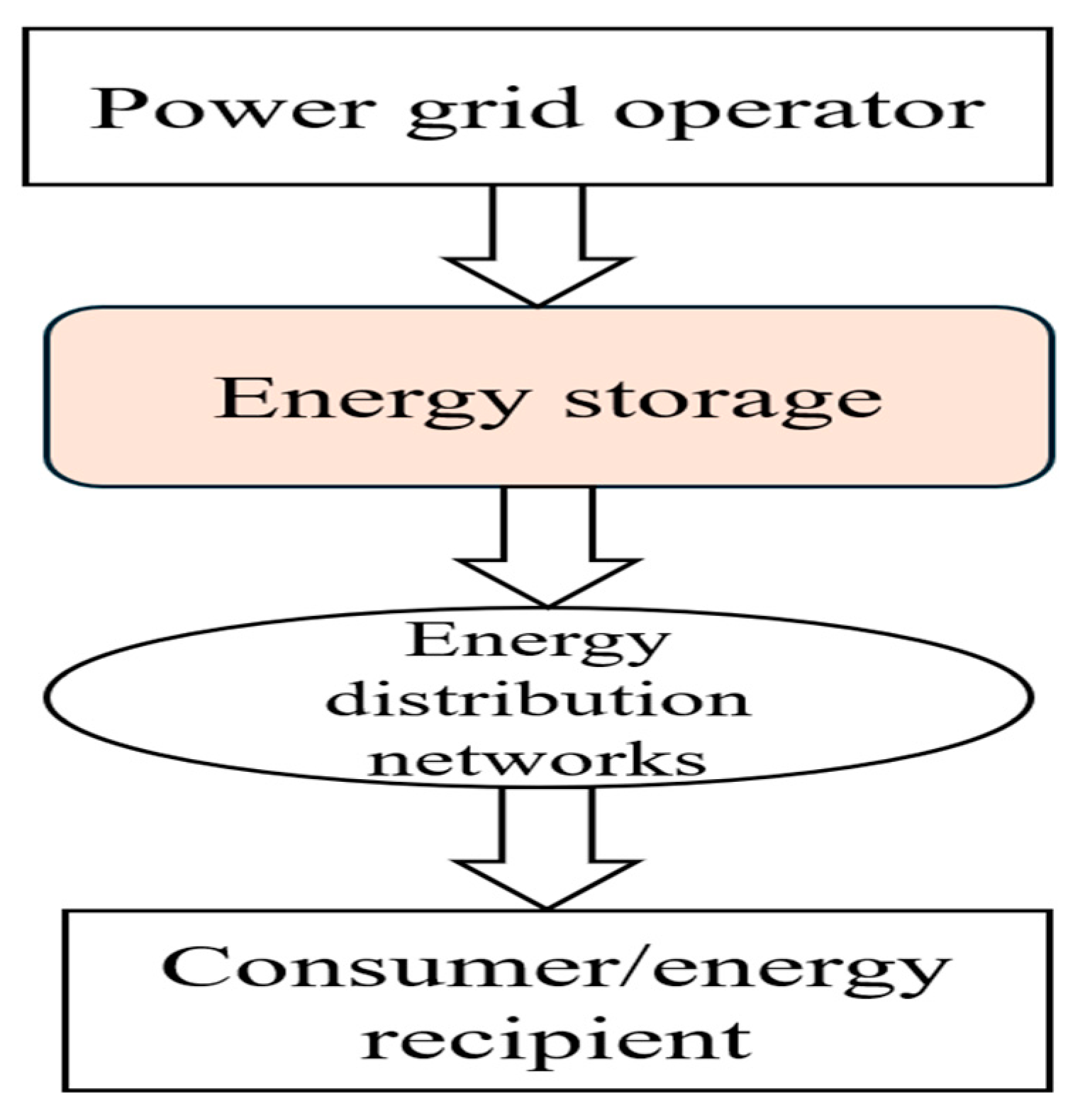

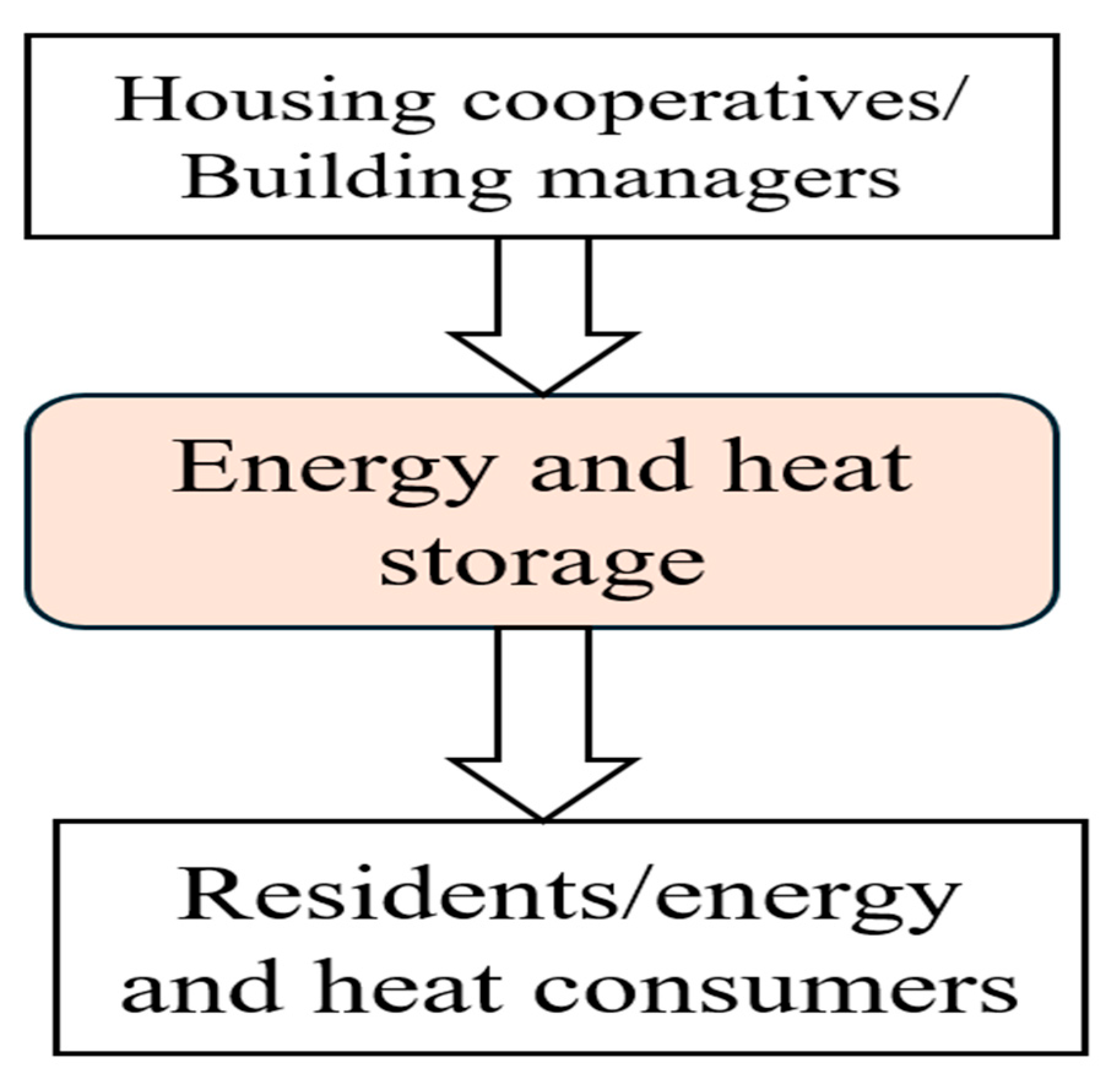
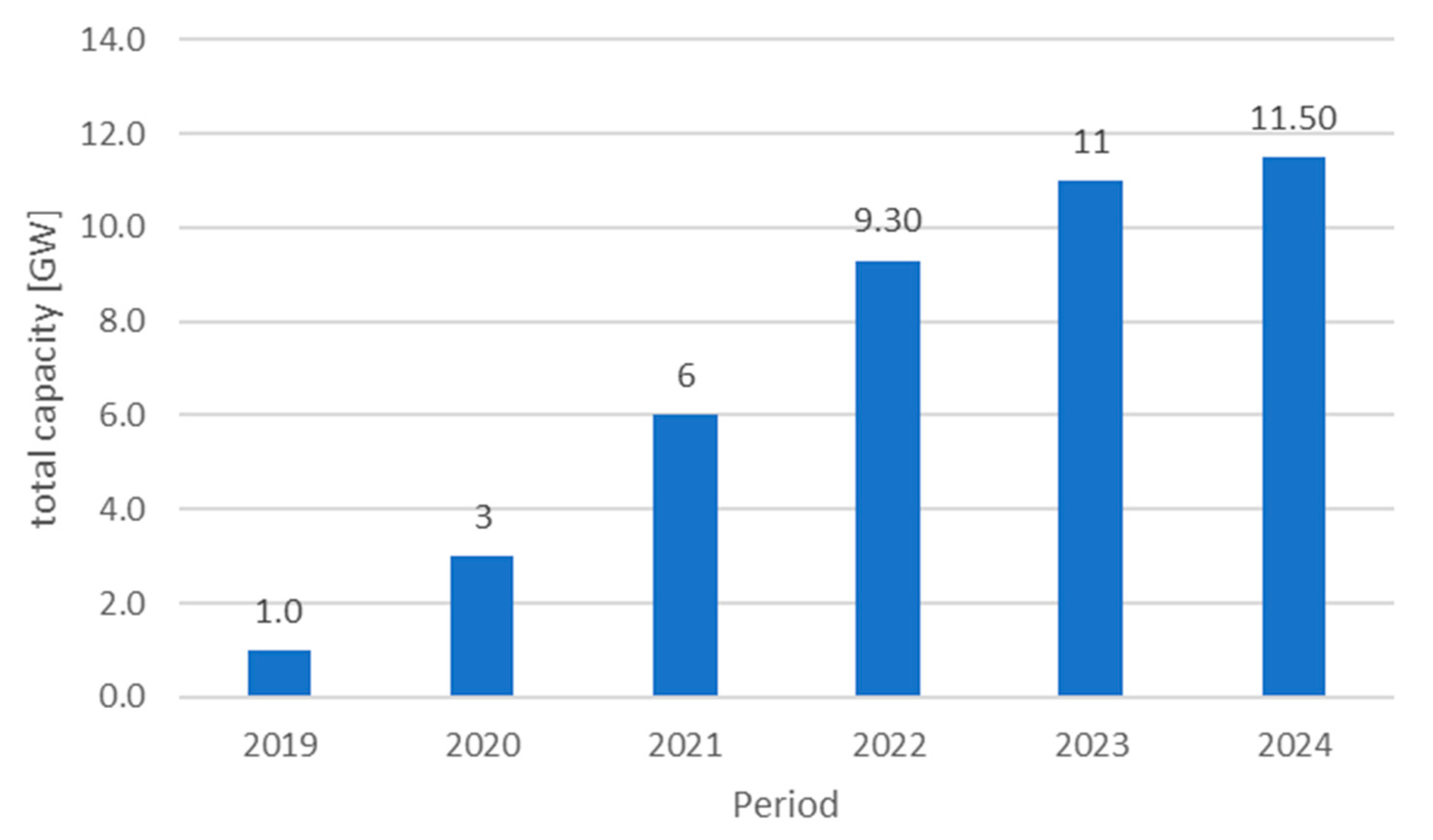
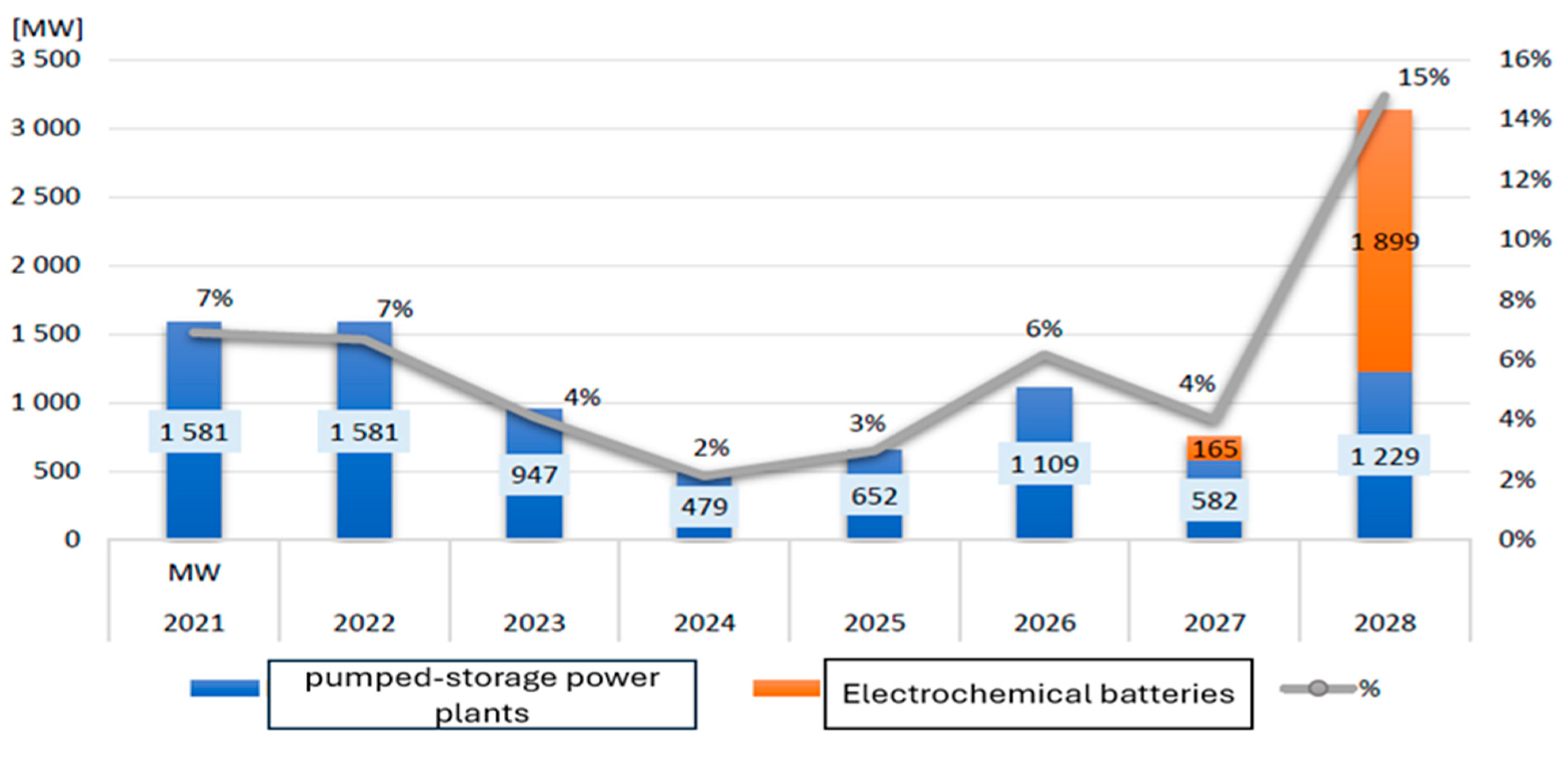
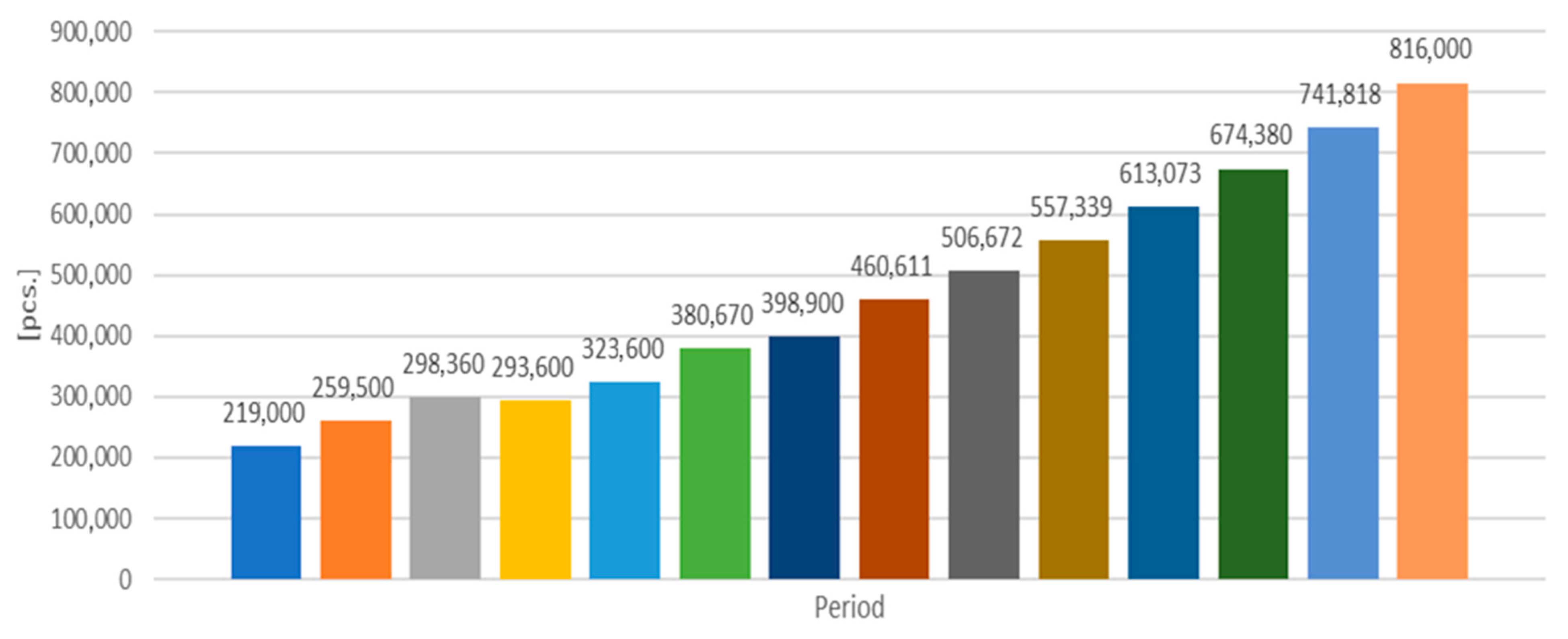
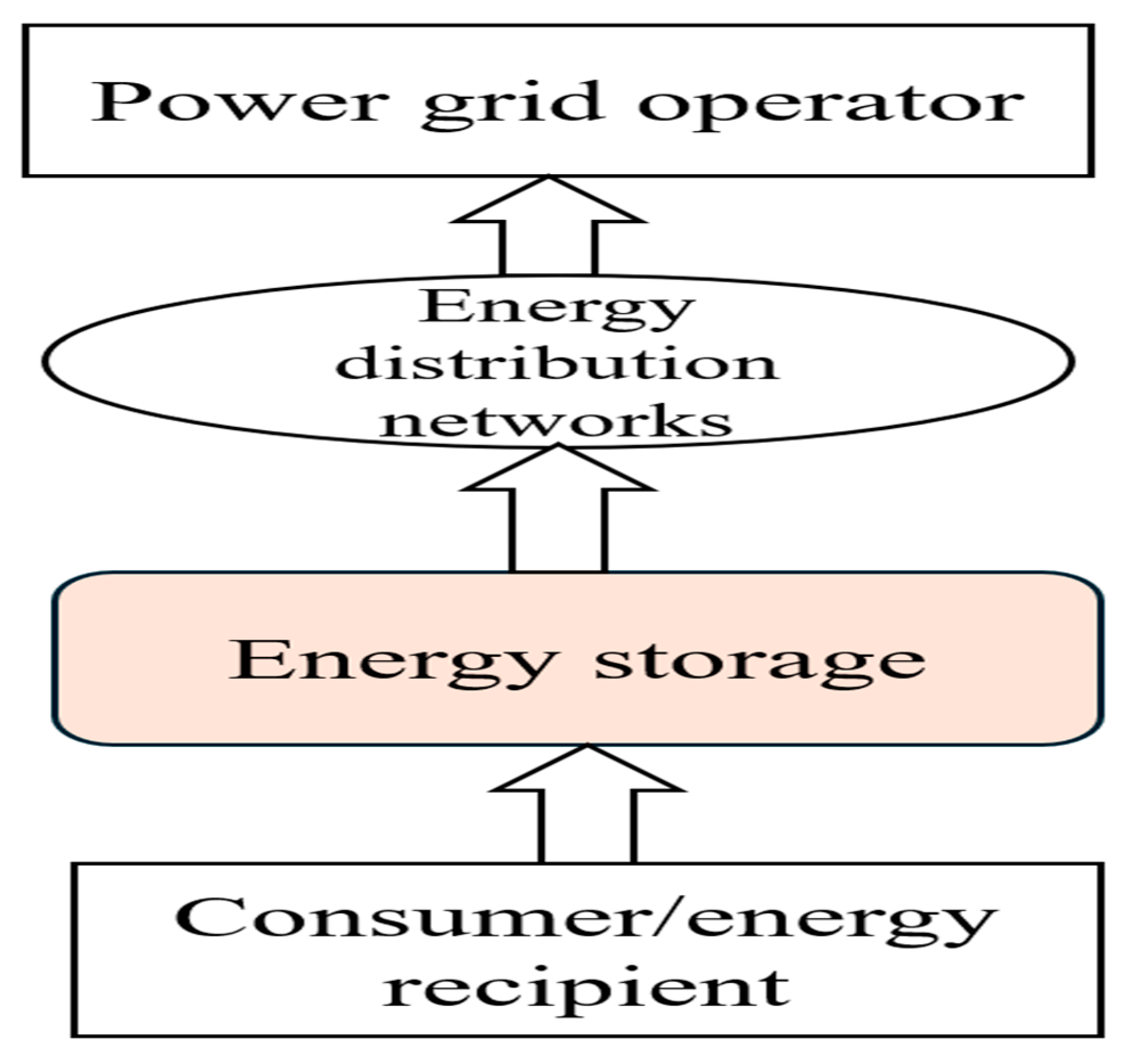
| Final Energy Consumption 2020 | TWh | Share [%] |
|---|---|---|
| Heat consumption | 447 | 53 |
| Electricity consumption | 170 | 20 |
| Transport fuel consumption | 228 | 27 |
| Gross final energy consumption | 846 | 100 |
| Power Grid Operator | Number of Warehouses | Number of kW |
|---|---|---|
| Polskie Sieci Elektroenergetyczne S.A. | 2 | 1,250,600 |
| PGE Dystrybucja S.A. | 2 | 200,748 |
| TAURON Dystrybucja S.A. | 4 | 1400 |
| ENERGA-OPERATOR S.A. | 2 | 6180 |
| ENEA Operator Sp. z o.o. | ND | ND |
| Stoen Operator Sp. z o.o. | 1 | 70 |
| PGE Energetyka Kolejowa S.A. | 1 | 5500 |
| Warehouse Name | Warehouse Technology | Total Installed Power [kW] | Capacity [kWh] | Efficiency [%] |
|---|---|---|---|---|
| PGE Energia Odnawialna S.A. | Pumped storage power plant | 710,000 | 3,800,000 | 78 |
| PGE Energia Odnawialna S.A. | Pumped storage power plant | 540,000 | 2,000,000 | 75 |
| Stoen Operator Sp. z o.o. | Lithium-ion batteries | 70 | 62 | 82 |
| PGE Dystrybucja S.A. | Lithium-ion batteries | 2088 | 4237 | 84 |
| PGE Energia Odnawialna S.A. | Pumped storage power plant | 198,660 | 640,000 | 79 |
| Tauron Ekoenergia Sp. z o.o | Lithium-ion batteries | 500 | 500 | 80 |
| Tauron Inwestycje Sp. z o.o | Electrochemical energy | 200 | 250 | 93 |
| Tauron Polska Energia S.A. | Electrochemical energy | 150 | 150 | 88 |
| PGE Energia Odnawialna S.A | Lithium-ion batteries with NMC cells | 550 | 750 | 90 |
| Energa Wytwarzanie S.A. | Hybrid rechargeable battery | 6000 | 15,000 | 70 |
| Orlen S.A. Branch PGNiG in Odolanow | Lithium-ion batteries | 180 | 403 | 98 |
| PKP Energetyka | Lithium-ion batteries | 5000 | 1200 | ND |
| Total | 1,464,498 | 6,462,552 |
Disclaimer/Publisher’s Note: The statements, opinions and data contained in all publications are solely those of the individual author(s) and contributor(s) and not of MDPI and/or the editor(s). MDPI and/or the editor(s) disclaim responsibility for any injury to people or property resulting from any ideas, methods, instructions or products referred to in the content. |
© 2025 by the authors. Licensee MDPI, Basel, Switzerland. This article is an open access article distributed under the terms and conditions of the Creative Commons Attribution (CC BY) license (https://creativecommons.org/licenses/by/4.0/).
Share and Cite
Dyczkowska, J.A.; Panek, A.; Chamier-Gliszczynski, N. Identification of Energy Storage in Distribution Channels. Energies 2025, 18, 4981. https://doi.org/10.3390/en18184981
Dyczkowska JA, Panek A, Chamier-Gliszczynski N. Identification of Energy Storage in Distribution Channels. Energies. 2025; 18(18):4981. https://doi.org/10.3390/en18184981
Chicago/Turabian StyleDyczkowska, Joanna Alicja, Aleksandra Panek, and Norbert Chamier-Gliszczynski. 2025. "Identification of Energy Storage in Distribution Channels" Energies 18, no. 18: 4981. https://doi.org/10.3390/en18184981
APA StyleDyczkowska, J. A., Panek, A., & Chamier-Gliszczynski, N. (2025). Identification of Energy Storage in Distribution Channels. Energies, 18(18), 4981. https://doi.org/10.3390/en18184981





